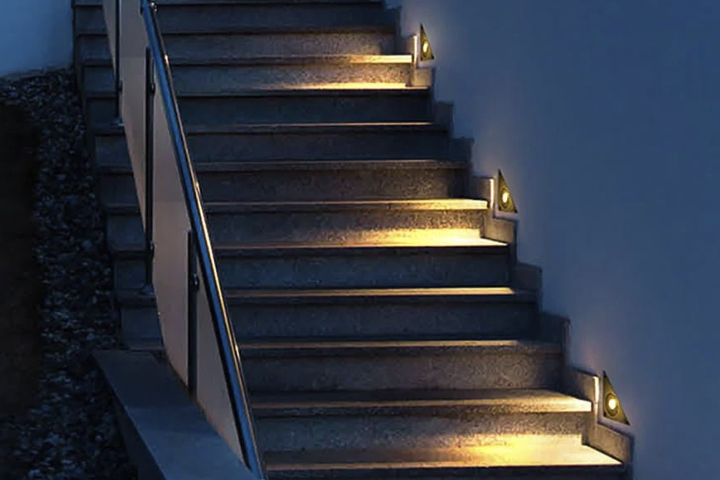
Illuminate Your Stairs with Embedded Step Lamp
Embedded step lamps are an innovative lighting solution that seamlessly integrates into staircases, providing both functionality and aesthetic appeal. These fixtures are designed to be installed directly into the risers or treads of stairs, creating a subtle yet effective source of illumination. The concept of embedded lighting has gained popularity in recent years, particularly in modern architectural designs where clean lines and minimalism are prioritized.
By embedding lights within the structure of the stairs, homeowners can enhance safety while simultaneously elevating the overall design of their living spaces. The evolution of embedded step lamps reflects a broader trend towards smart home technology and energy efficiency. Many of these lamps utilize LED technology, which not only consumes less power but also boasts a longer lifespan compared to traditional incandescent bulbs.
This shift towards energy-efficient lighting solutions aligns with growing environmental awareness and the desire for sustainable living. As more homeowners seek to create inviting and safe environments, embedded step lamps have emerged as a practical choice that combines safety, style, and sustainability.
Benefits of Installing Embedded Step Lamps on Your Stairs
Safety First
Stairs can be hazardous, especially in low-light environment. By illuminating each step, these lamps Ladanmu help prevent accidents such as slips and falls, making them particularly valuable for households with children or elderly residents.
Ambient Lighting
The soft glow emitted by embedded lamps provides just enough light to guide individuals safely up and down the stairs without being overly harsh or distracting. This is especially important in homes where stairs are frequently used at night or in dimly lit areas.
Aesthetic Appeal
In addition to safety, embedded step lamps contribute to the overall aesthetic of a home. They can be designed to complement various architectural styles, from contemporary to traditional. The discreet nature of embedded lighting allows for a clean and uncluttered look, which can enhance the visual appeal of staircases. Furthermore, the strategic placement of these lamps can highlight architectural features or artwork along the staircase, adding an artistic dimension to the space.
How to Choose the Right Embedded Step Lamp for Your Stairs
Selecting the appropriate embedded step lamp involves several considerations that can significantly impact both functionality and aesthetics. First and foremost, it is essential to assess the brightness level required for your specific staircase. The amount of light needed may vary depending on the size of the stairs, the height of the risers, and the overall layout of the surrounding area.
For instance, a narrow staircase may require brighter lights to ensure visibility, while a wider staircase might benefit from softer illumination that creates a more inviting atmosphere. Another critical factor is the design and style of the embedded step lamps. Homeowners should consider how the lamps will integrate with their existing décor and architectural elements.
Options range from sleek, modern designs with minimalist features to more ornate styles that can add character to traditional homes. Additionally, color temperature plays a vital role in setting the mood; warmer tones can create a cozy ambiance, while cooler tones may lend a more contemporary feel. It is also advisable to consider energy efficiency ratings and durability, as these factors will influence long-term performance and maintenance needs.
Installation Process of Embedded Step Lamps
The installation process for embedded step lamps can vary depending on the specific product and the existing structure of the stairs. However, there are general steps that most installations will follow. Initially, it is crucial to plan the layout carefully.
This involves determining where each lamp will be placed for optimal illumination and ensuring that they are evenly spaced along the staircase. Marking these locations on the risers or treads will help guide the installation process. Once the layout is established, the next step typically involves cutting openings in the stairs to accommodate the lamps.
This requires precision and care to avoid damaging the surrounding materials. Depending on whether the stairs are made of wood, concrete, or another material, different tools may be necessary for cutting. After creating the openings, electrical wiring must be run to each lamp location.
This step often requires knowledge of electrical systems and may necessitate hiring a licensed electrician to ensure compliance with local codes and safety standards. After wiring is complete, the embedded lamps can be installed into their respective openings. This usually involves securing them in place with screws or adhesive, depending on the design of the lamp.
Once installed, it is essential to test each lamp to ensure proper functionality before finishing any surrounding work, such as painting or sealing edges. Proper installation not only ensures safety but also maximizes the aesthetic appeal of the embedded lighting.
Maintenance and Care Tips for Embedded Step Lamps
Maintaining embedded step lamps is crucial for ensuring their longevity and optimal performance. Regular cleaning is one of the simplest yet most effective ways to care for these fixtures. Dust and debris can accumulate over time, diminishing light output and affecting overall appearance.
Homeowners should periodically wipe down the surfaces of the lamps with a soft cloth or microfiber towel to remove any buildup without scratching or damaging them. In addition to cleaning, it is important to check for any signs of wear or damage regularly. This includes inspecting wiring connections and ensuring that all components are securely fastened.
If any issues are detected—such as flickering lights or unusual sounds—prompt attention is necessary to prevent further complications. For LED lamps, it is also advisable to monitor their brightness levels; if they begin to dim significantly, it may indicate that replacement is needed. Another aspect of maintenance involves ensuring that any surrounding areas remain clear of obstructions that could interfere with light output or pose safety hazards.
This includes keeping stairways free from clutter and ensuring that any decorative elements do not block light paths. By following these maintenance tips, homeowners can enjoy their embedded step lamps for many years while maintaining both safety and aesthetic appeal.
Creative Ways to Use Embedded Step Lamps in Your Home
Embedded step lamps offer versatility beyond mere stair illumination; they can be creatively utilized in various areas throughout a home. One innovative application is using them in hallways or corridors where traditional lighting may not be sufficient or aesthetically pleasing. By embedding lights along the baseboards or within wall recesses, homeowners can create a continuous flow of light that guides visitors through spaces without overwhelming brightness.
Another creative use for embedded step lamps is in outdoor settings, such as garden paths or patios. When installed along outdoor steps or walkways, these lamps enhance safety while adding an enchanting ambiance during evening gatherings or quiet nights under the stars. Weather-resistant models designed specifically for outdoor use can withstand environmental elements while providing reliable illumination.
Additionally, embedded step lamps can serve as accent lighting in various rooms within a home. For example, they can be integrated into built-in shelving units or around fireplaces to highlight decorative items or artwork. This not only enhances visual interest but also creates a warm and inviting atmosphere in living spaces.
By thinking outside traditional applications, homeowners can maximize the potential of embedded step lamps throughout their homes, transforming ordinary spaces into extraordinary experiences through thoughtful lighting design.
